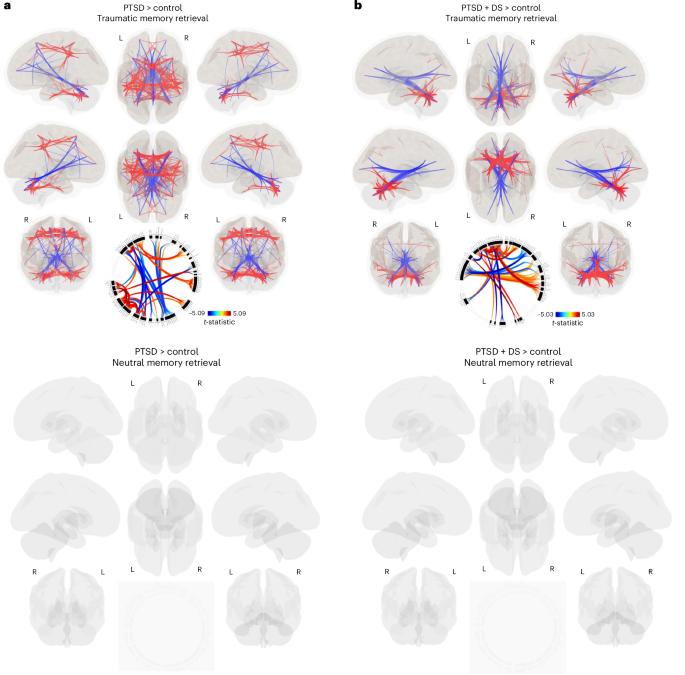Reduced cerebello-thalamo-cortical functional connectivity during traumatic memory retrieval in PTSD
IF 8.7
引用次数: 0
Abstract
Traumatic memory retrieval is marked by vivid sensations, temporal fragmentation and a sense of reliving the past. Here we apply an unrestricted, whole-brain connectome approach to examine neutral and traumatic memory retrieval using functional magnetic resonance imaging in 90 individuals: those with post-traumatic stress disorder (PTSD, n = 46) and its dissociative subtype (PTSD + DS, n = 19) versus trauma-exposed controls (n = 25). Both PTSD and PTSD + DS exhibited hypoconnectivity in cerebrocerebellar and basal ganglia–cerebellar circuits alongside increased intracerebellar connectivity during traumatic memory retrieval only, reflecting a segregated cerebellar topology and a breakdown in long-range cortical connections. Brainstem–cerebellar hyperconnectivity was observed in PTSD + DS relative to controls during traumatic memory retrieval and in all participants with PTSD when directly comparing traumatic versus neutral memory retrieval. PTSD + DS exhibited additional hypoconnectivity between occipital regions and the thalamus and basal ganglia. These findings suggest a disruption to subcortical–cortical ‘vertical’ integration during traumatic memory retrieval, where cerebellar-based predictive processes may be markedly altered. This study uses whole-brain connectome analysis via functional MRI to investigate memory retrieval in individuals with post-traumatic stress disorder and its dissociative subtype, revealing distinct connectivity patterns and disruptions in subcortical–cortical integration during traumatic versus neutral memory processing.

创伤后应激障碍患者创伤记忆提取过程中小脑-丘脑-皮质功能连通性降低
创伤性记忆的恢复以生动的感觉、时间碎片和重温过去的感觉为特征。在这里,我们采用不受限制的全脑连接体方法,使用功能性磁共振成像检查90个人的中性记忆和创伤记忆检索:创伤后应激障碍(PTSD, n = 46)及其分离亚型(PTSD + DS, n = 19)与创伤暴露对照组(n = 25)。PTSD和PTSD + DS均表现出脑小脑和基底神经节-小脑回路的低连通性,仅在创伤记忆检索时小脑内连通性增加,反映了小脑拓扑结构的分离和远距离皮质连接的破坏。在创伤性记忆提取过程中,PTSD + DS组相对于对照组观察到脑干-小脑超连通性,在直接比较创伤性记忆和中性记忆提取时,所有PTSD参与者都观察到脑干-小脑超连通性。PTSD + DS在枕区与丘脑和基底神经节之间表现出额外的低连通性。这些发现表明,在创伤性记忆提取过程中,皮层下-皮层“垂直”整合被破坏,小脑的预测过程可能被显著改变。本研究通过功能性MRI对创伤后应激障碍及其分离亚型个体的记忆提取进行了全脑连接组分析,揭示了创伤性和中性记忆加工过程中不同的连接模式和皮层下-皮层整合的中断。
本文章由计算机程序翻译,如有差异,请以英文原文为准。
求助全文
约1分钟内获得全文
求助全文

 求助内容:
求助内容: 应助结果提醒方式:
应助结果提醒方式:


